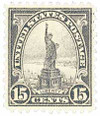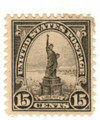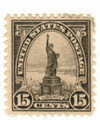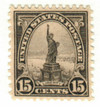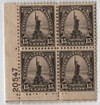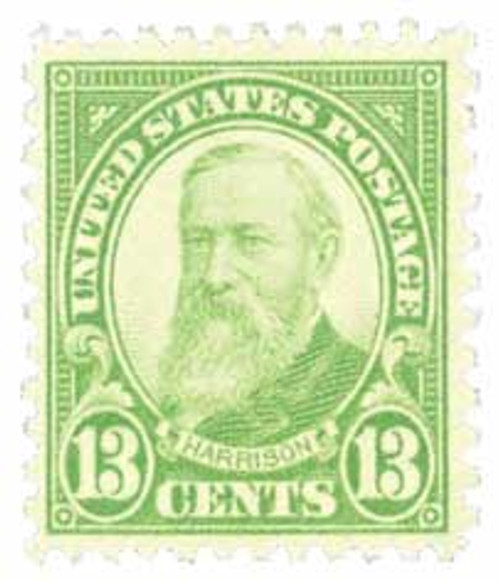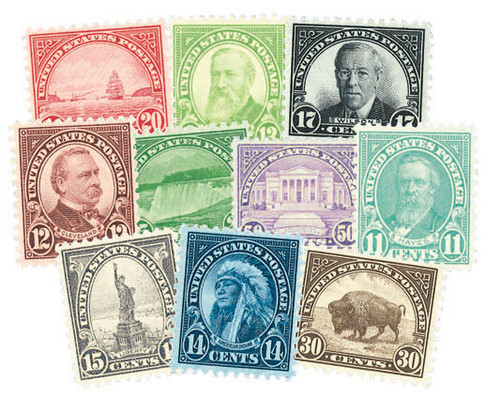
# 696 - 1931 15c Statue of Liberty, gray
Series of 1931 15¢ Statute of Liberty
1922-26 Designs
First City: Washington, D.C.
Quantity Issued: Unknown
Printed by: Bureau of Engraving and Printing
Printing Method: Rotary Press
Perforation: 11 x 10 ½
Color: Gray
Grover Cleveland Dedicates Statue Of Liberty
On October 28, 1886, the Statue of Liberty was completed and dedicated.
French politician and writer Édouard René de Laboulaye was one of the first to suggest giving America a gift to mark the centennial of the American Declaration of Independence. French sculptor Frédéric Bartholdi designed the sculpture and Gustave Eiffel (designer of the Eiffel Tower) designed the iron pylon and skeletal framework of the statue.
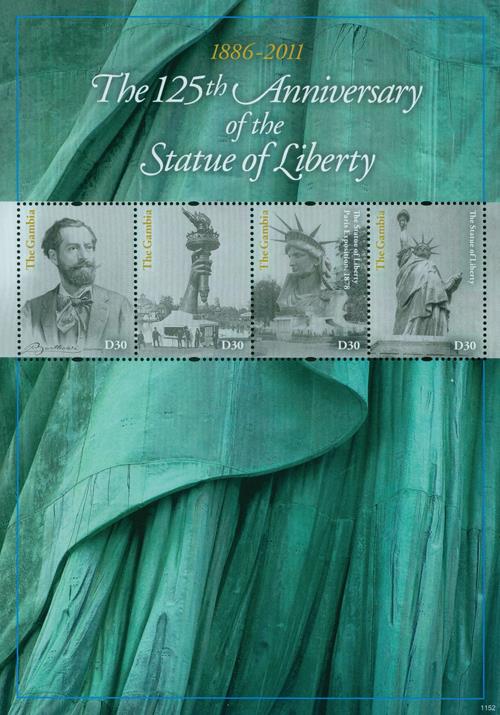
To fund the statue, the people of France made public donations. Performances were also used to raise money, including La liberté éclairant le monde (Liberty enlightening the world) by future famous composer Charles Gounod. In all, $250,000 was raised. Similarly, the U.S. – which had agreed to build the statue’s base – held several benefit events, art exhibitions, auctions and prizefights to raise money.
Although Laboulaye initially planned to present the statue to America in 1876, a late start and several delays made this impossible. The right arm and torch were completed in time, and were put on display at the Centennial Exposition in Philadelphia. The statue was completed in France in 1884 and shipped to America in 350 separate parts. It arrived in June 1886 and was reassembled while electricians worked on lighting the torch.
The last piece was riveted in place during the dedication ceremony on October 28, 1886. President Grover Cleveland presided over the ceremony and delivered a stirring speech:
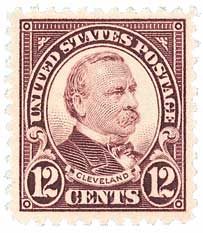
“We are not here today to bow before the representation of a fierce warlike god, filled with wrath and vengeance, but we joyously contemplate instead our own deity keeping watch and ward before the open gates of America and greater than all that have been celebrated in ancient song. Instead of grasping in her hand thunderbolts of terror and of death, she holds aloft the light which illumines the way to man’s enfranchisement. We will not forget that Liberty has here made her home, nor shall her chosen altar be neglected. Willing votaries will constantly keep alive its fires and these shall gleam upon the shores of our sister Republic thence, and joined with answering rays a stream of light shall pierce the darkness of ignorance and man’s oppression, until Liberty enlightens the world.”
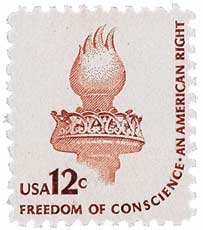
The dedication ceremony was followed by a fireworks display and New York City’s first ticker tape parade. The 151-foot copper statue was modeled in a classic Roman style based on Libertas, the ancient Roman goddess of freedom from slavery, oppression, and tyranny. The crown of seven spikes represents the Seven Seas and the seven continents, while the torch symbolizes enlightenment. Lady Liberty holds a tablet that is representative of knowledge, and reads “July 4, 1776,” the date of the Declaration of Independence.
Historians debate who Liberty’s face is modeled after, but it’s likely one of two women. Some believe it was Isabella Eugene Boyer, the recently widowed wife of Isaac Singer, creator of the Singer sewing machine. Others believe the statue was modeled after sculptor Frédéric Bartholdi’s mother, Charlotte Bartholdi.
Series of 1931 15¢ Statute of Liberty
1922-26 Designs
First City: Washington, D.C.
Quantity Issued: Unknown
Printed by: Bureau of Engraving and Printing
Printing Method: Rotary Press
Perforation: 11 x 10 ½
Color: Gray
Grover Cleveland Dedicates Statue Of Liberty
On October 28, 1886, the Statue of Liberty was completed and dedicated.
French politician and writer Édouard René de Laboulaye was one of the first to suggest giving America a gift to mark the centennial of the American Declaration of Independence. French sculptor Frédéric Bartholdi designed the sculpture and Gustave Eiffel (designer of the Eiffel Tower) designed the iron pylon and skeletal framework of the statue.

To fund the statue, the people of France made public donations. Performances were also used to raise money, including La liberté éclairant le monde (Liberty enlightening the world) by future famous composer Charles Gounod. In all, $250,000 was raised. Similarly, the U.S. – which had agreed to build the statue’s base – held several benefit events, art exhibitions, auctions and prizefights to raise money.
Although Laboulaye initially planned to present the statue to America in 1876, a late start and several delays made this impossible. The right arm and torch were completed in time, and were put on display at the Centennial Exposition in Philadelphia. The statue was completed in France in 1884 and shipped to America in 350 separate parts. It arrived in June 1886 and was reassembled while electricians worked on lighting the torch.
The last piece was riveted in place during the dedication ceremony on October 28, 1886. President Grover Cleveland presided over the ceremony and delivered a stirring speech:

“We are not here today to bow before the representation of a fierce warlike god, filled with wrath and vengeance, but we joyously contemplate instead our own deity keeping watch and ward before the open gates of America and greater than all that have been celebrated in ancient song. Instead of grasping in her hand thunderbolts of terror and of death, she holds aloft the light which illumines the way to man’s enfranchisement. We will not forget that Liberty has here made her home, nor shall her chosen altar be neglected. Willing votaries will constantly keep alive its fires and these shall gleam upon the shores of our sister Republic thence, and joined with answering rays a stream of light shall pierce the darkness of ignorance and man’s oppression, until Liberty enlightens the world.”

The dedication ceremony was followed by a fireworks display and New York City’s first ticker tape parade. The 151-foot copper statue was modeled in a classic Roman style based on Libertas, the ancient Roman goddess of freedom from slavery, oppression, and tyranny. The crown of seven spikes represents the Seven Seas and the seven continents, while the torch symbolizes enlightenment. Lady Liberty holds a tablet that is representative of knowledge, and reads “July 4, 1776,” the date of the Declaration of Independence.
Historians debate who Liberty’s face is modeled after, but it’s likely one of two women. Some believe it was Isabella Eugene Boyer, the recently widowed wife of Isaac Singer, creator of the Singer sewing machine. Others believe the statue was modeled after sculptor Frédéric Bartholdi’s mother, Charlotte Bartholdi.




